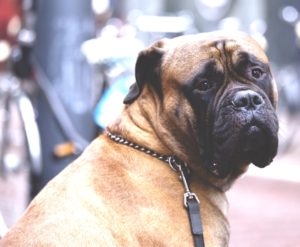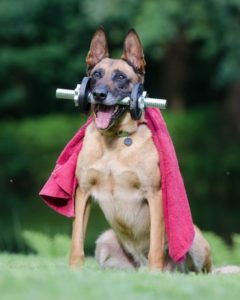If you read my earlier article about the health risks of obesity, you might have been inspired (or scared!). If your pet needs to lose weight, the time to start is now. First, accept the fact that weight loss takes time – often months. If you have a large dog who has mobility issues, losing weight is hard, because exercise is obviously limited. If you have an obese cat, weight loss must happen slowly – to the tune of one pound every couple months! (Here’s my article explaining cats and their problem livers). And we all know getting a cat to exercise can be a challenge (getting a cat to do anything can be a challenge!).
It’s always a good idea to talk to your veterinarian about starting a weight loss program. There are some medical causes that can make a pet gain weight that are good to initially rule out. I can’t tell you how many fat dogs I’ve tested thyroid levels on, to disappointedly call the owner and report “bummer, your dog’s thyroid is perfectly healthy.” Cats tend to not develop low thyroid function, so we don’t have that rule-out for them. If you go to a clinic where you are rushed in and out in 10 minutes, and have no time to discuss weight management (it doesn’t need to take an hour – 5 extra minutes is fine) maybe shop for a new vet. Your veterinarian can give you a rough idea how much your pet should weigh. Sometimes it’s very hard to tell in obese animals. We’ll give you a goal, and may adjust that goal as weight loss happens.
Determine how much food your pet is currently eating
If you want to get the weight off your pet without changing diets, the first thing we need to do is determine how much the pet is actually eating. This involves measuring cups. The kind you cook with. A pet food scoop or a large cup from the gas station does not constitute a measuring cup! Buy a designated cup from the kitchenware department of the store. Many vets even have measuring cups they can give you!
If you normally fill up the bowl, do that, and then scoop it into the measuring cup, one cup at a time, to determine how much your pet is eating. There might be variability from day to day, so I suggest doing this a few times and taking the average. If your pet is like Gunther, and is getting 10 cups of food a day, going down to the 4 cups or so he needs might really rock his world. We need to ease them down.
 If the amount is excessive, reduce slowly
If the amount is excessive, reduce slowly
A good rule of thumb is reduction by 25%. So if your dog is getting 10 cups, reducing to 7.5 cups a day for a month will be an adjustment! Then go down to about 5 cups for a month, then go down to the 4 cups he needs. Just even getting to the level he should be eating takes a couple months! (Back to that whole weight loss being slow thing!). Of course, if food is left in the bowl, we can decrease the amount we’re feeding faster, since the pet isn’t eating it all anyway!
With cats, we need to remember that a little goes a long way! Grab a golf ball or a ping pong ball. That’s about how big your cat’s stomach is. Clearly one cup of food three times a day is way too much! Many people feel like they are starving their cat, because the recommended quantities of food to feed are so small. It’s because we look at it and put ourselves in their shoes (“I would need more food than that.”) But we aren’t cats. Think golf ball.
Again, fill the bowl, and measure how much food it actually is. With cats the 25% reduction rule really holds! We cannot have them losing weight too quickly. Many cat owners prefer dry food, because cats are grazers, and it’s easier to leave that out all day. However, we’ve realized that canned food is actually much better for fat cats’ metabolisms than dry! (Here’s my article explaining why). If possible, getting your obese cat on canned food – any kind – may actually help weight loss!
If you have multiple cats that all share from the same bowls, portion control is next to impossible. It always seems when owners try that, the fat cat gets fatter and the skinny cat gets skinnier! Cats are grazers, so their bodies prefer to get 3-4 meals a day, not two like is easier for our schedules. With multi-cat households, it takes a lot of dedication to get weight off one of the cats. Food cannot be left down all the time. Cats must be separated for meal time (remember, more than three meals a day is ideal!) and fed specific quantities. The small frequent feedings work well with canned foods. But, I get it – if you work long hours and can’t feed your cats every 6-8 hours, what to do? Do your best. You might be one that needs to consider a prescription diet. Ask your veterinarian for specific guidance.
The most important things to remember are measuring, accuracy, and consistency! But what if the amount of food going into your pet at mealtimes is not excessive? Often the food is only part of the problem in overweight pets.
The real problem – treats!
Many owners of obese pets proudly tell me “…but she gets NO table scraps!” That’s fine. Problem is, commercial treats are loaded with calories! In my opinion, these treats are sometimes worse than getting table food! I have many owners that feed an appropriate or near-appropriate amount of food…and supplement it with dog biscuits, chewy treats, dental chews, etc. I often equate that to eating three healthy meals a day, and then eating a candy bar between every meal. Not exactly a good diet!
Let’s think about calories.
- The average indoor cat needs roughly 250 calories a day.
- A 20 lb dog (a dog who maybe weighs 25lbs and SHOULD weigh 20) needs about 450-500 calories a day.
- A 50 lb dog needs roughly 900 calories a day.
- A dog whose lean body weight would be 100 lbs (not your lab that weighs 100 lbs and should weigh 70) needs about 1500 calories a day.
Your veterinarian can calculate how many daily calories your particular dog or cat needs, but this is at least a rough idea to get the conversation started. Obviously, your pet’s body composition and activity level play a huge role! If your dog gets walked 3 miles twice a day, or trains in agility, she will need more calories than the couch potato. These calorie estimates at last give you a vague starting point, then talk to your veterinarian about specifics.
Now that we know roughly how many calories to shoot for, let’s check out some specific treats.
Milk Bones. The standard biscuit many people reach for. One Medium biscuit contains 40 calories. One Large biscuit contains over 100 calories! If you feed 3 of those to your dog each day, that’s almost 350 calories just in treats! We haven’t even gotten to food yet!
Busy Bone. I feed these to my dogs on occasion. They love them. But they cannot get them on a regular basis! One Large Busy Bone is a whopping 600 calories!! The Small/Medium is over 300 calories!! Jumbone by Pedigree is about the same – 600 calories for the large! Pedigree Dental chews were a bit less obnoxious for calorie content – the Small/Medium has 53 calories per stick, and the Large have 76 calories per stick.
These are just a few examples, to give you an idea of the calories going into your pet. Feeding organic treats? Calorie content is not all that different, so don’t think organic means low calorie – it does not!
Treats are not bad! I give my dogs treats and dental chews of various brands and varieties. We just need to remember they are treats, and should not make up more than 10% of your pet’s caloric intake per day. Just like dessert shouldn’t make up more than 10% of our intake!
Thankfully, companies are now making “training treats” or other designations which are small in size and very low calorie. They are intended for frequent use, as in training, but I recommend them for daily use as well. Charlee Bear is one brand that is 4 calories a treat. Pedigree Puppy Trainers are 5 calories a treat. These are not endorsements, but examples to steer you in the right direction. Know that low calorie treats are out there!
Breaking up is not hard to do
Dogs and cats enjoy the frequency of treats less than they enjoy size. If your dog gets a biscuit every time he comes in from outside, we can reduce calories simply by breaking that treat in half, or even smaller. Instead of 3 large milk bones a day, take one biscuit, break it into 3 pieces, and he gets SO many less calories, without feeling wronged. Soft chewy treats are easy to break as well. I recommend a piece as big as my thumbnail for most dogs (obviously exceptionally large or tiny dogs will differ).
Table food is not the enemy
Many vets make blanket statements: “NO TABLE FOOD.” Not so fast. If you’re a raw vegan, share table food all you want! For the rest of us, healthy human food is (generally) healthy for your pet! I have a cat patient who loves frozen peas. Two of my dogs love carrot pieces. Many people mix green beans with their dog’s food to help them feel more full during weight loss programs. Apple pieces, in moderation, are great! I have both a cat and a dog patient who love blueberries. One of my dogs loves the crunchy stalky part of romaine lettuce. Notice I have not recommended sharing the pot roast. Or the apple pie.
Be creative, and try vegetables with your pet! Fruits can be a little higher in calorie, so even though it is healthy, we must remember moderation. Just remember to avoid the fruits and veggies poisonous to cats and dogs: raisins, grapes, onions, garlic.
I often recommend Cheerios as treats! Any non-sugary breakfast cereal will do. Think about how many Cheerios you get in a cup for about 100 calories. Give your dog one piece at a time for a treat – we’re talking maybe 1 calorie per treat! Another great treat alternative that helps your pet’s weight and your budget – ice chips! When small, some dogs love the crunch!
Grain-free is not the answer!
Many owners feed grain free food to their pet on the assumption that grain is somehow bad for their pet. If your pet is in the 1% that is truly allergic to grain, then yes, continue feeding grain free. The rest of us who saw an ad on TV or read a website, we might have noticed that once we started feeding grain free, our pet started gaining more weight. Sometimes they have chronic intermittent loose stool, because we do need fiber to hold things together! If your pet is overweight, switching from grain free to the regular version of whatever food you’re feeding can help get a little weight off, and also help improve stool quality. (My upcoming e-book will go into great detail on this issue)
Diet dog and cat food
Many foods claim to be “weight management” or “healthy weight.” This is a relative term. All it means is it might have less calories than the “regular” version, but it is not necessarily a low-calorie food. Still, less calories is always good! Once you have the quantity normalized, a gradual switch (mixing the foods 50/50 for about 10 days is enough for most pets) could be all you need to get a couple extra pounds off.
In general, senior diets are lower in calorie than regular, and puppy/kitten diets tend to be the highest in calorie. For cats, hairball formulas often have more fiber and are lower in calorie than even the weight management formulas! (I am currently writing an e-book on pet food that will cover this topic in detail.)
Prescription food
I often recommend prescription diets for obese pets, especially once we’ve ruled out simple overfeeding (if the yorkie was eating 3 cups a day, simply feeding a normal amount might eliminate the need to change diets.) There are no drugs, or any magical ingredients that makes them prescription. The reason is, the manufacturers want these diets fed under some veterinary supervision, as that increases the chance of them working. Examples of prescriptions diets would be Metabolic, w/d, r/d (all by Hill’s Science Diet), Satiety or Weight Control (by Royal Canin), OM (by Purina Pro Plan), or Weight Loss or Weight Control (by Iams). Diets vary, but they are generally lower in calorie, and have very precisely calculated protein, fat, and carbohydrate ratios. Veterinary diets are very effective and well received by the patients. They come in dry and canned. For overweight cats, I recommend canned versions as much as feasible for the owner.
 It isn’t all diet – exercise is very important!
It isn’t all diet – exercise is very important!
We’ve focused on feeding in this article, but the elephant in the room is that most of our pets are rather sedentary. We work all day, while they nap. Then they lounge, then they ponder and relax before napping again. It’s a rough life. Restricting calories is important, but regular exercise is just as important! Not only does it help with weight loss, it’s good mentally, and helps maintain muscle and joint health.
Obviously, dogs are easier to exercise than cats. Throw a ball, or put on a leash and go for a walk. Have a doggy friend come over. Play tug. Cats are tricky. Some love the laser pointer game! Others do well on a harness and going for short walks around the neighborhood. The toy on the end of a string is often a hit. For cats, I also recommend things like climbing activities, having the food elevated where they have to climb for it, or even placing food in various hard to reach spots. I have many feline patients who will fetch a toy, so get creative! I have a client who runs through the house playing tag with her cat!
If your pet is not used to exercising, ease him in. Start with 5 minute walks or play sessions, and see how we do. Then go to 10 minutes, slowly working up to 30. Again, talk to your vet and make sure your pet is healthy enough for exercise prior to beginning. I put many of my obese dogs on arthritis medication, just because moving all that weight around makes them sore and painful. If it hurts, he won’t want to do it, and we want exercise to be pleasant! Once the weight comes off, we eliminate the medications.
Weight loss in pets is hard. It takes a long time, which can make it feel like a non-rewarding endeavor. Weigh-ins at your vet once a month can give you encouragement (assuming the numbers are going in the right direction!) or help us see what isn’t working. Some cat owners even buy a baby scale to accurately weigh at home – I love that idea!
If your pet seems to be losing, then gains a pound, don’t lose heart. Remember all living beings have day to day fluctuations. I recommend weighing at home weekly, or in a clinic monthly. Daily weigh-ins can just mess with your emotions. Keep your eyes on the goal, and remember that if it seems hard now, obesity-related complications are much harder!
